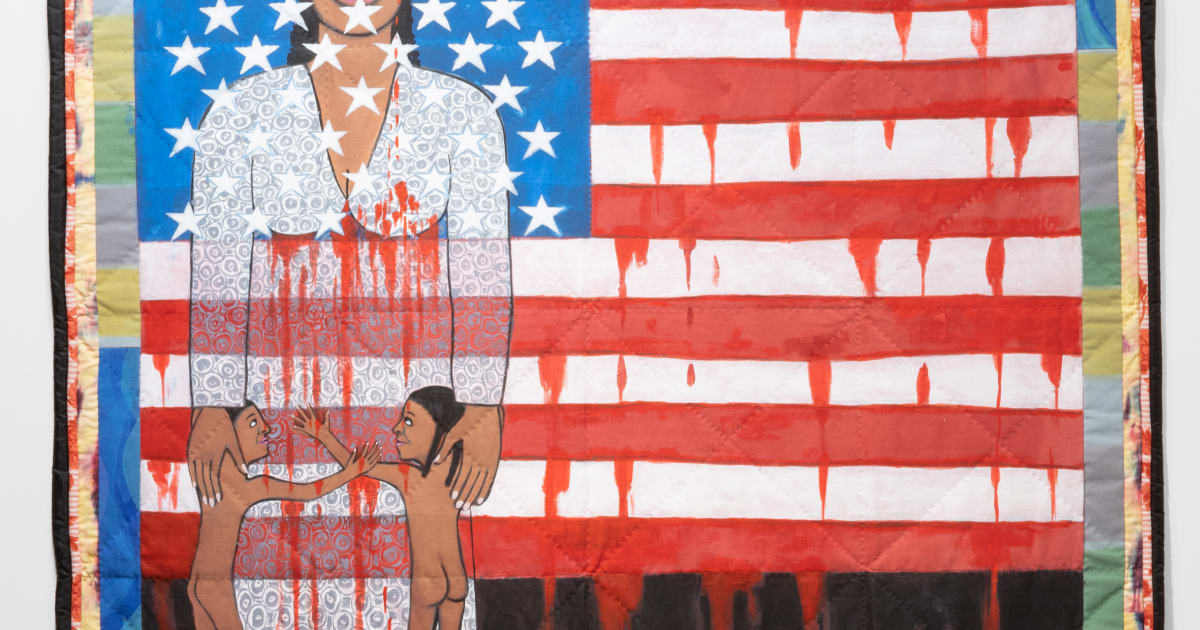The American People Series #18: The Flag Is Bleeding

The air in the gallery hummed with a quiet reverence, a shared breath held captive by the stark image before us. Red paint, thick and visceral, cascaded down the stripes of an American flag, pooling on the canvas like a fresh wound. Sunlight, filtered through the skylight above, seemed to catch the crimson, making it pulse with a life of its own.
The American People Series #18: The Flag Is Bleeding, a poignant and unsettling work by the late artist Robert Colescott, continues to resonate decades after its creation. It challenges viewers to confront the complex and often contradictory realities of American identity, particularly its relationship with race, power, and historical trauma.
Colescott: A Voice Born from the Margins
Born in 1925 in Oakland, California, Colescott's artistic journey was one of constant negotiation with the art world's predominantly white gaze. His parents, both classically trained musicians, instilled in him a deep appreciation for culture and creativity. He served in the U.S. Army in Europe during World War II, an experience that deeply impacted his understanding of national identity.
He pursued formal art education, earning a BA and MA from the University of California, Berkeley. Yet, despite his talent and training, Colescott faced considerable barriers due to his race.
He spent years painting in a more abstract style, a decision he later confessed was partially driven by a desire to be accepted by the mainstream art establishment. However, he felt a growing disconnect between his art and his lived experience as a Black man in America.
Breaking the Mold: Confronting Stereotypes
In the 1970s, Colescott underwent a radical stylistic shift, embracing figuration and narrative in a way that was both bold and unapologetic. He began to incorporate stereotypical imagery, drawn from popular culture and historical representations of African Americans.
He used these stereotypes not to reinforce them, but to deconstruct them, exposing their absurdity and the underlying power dynamics they represented. His work often employed satire and humor, but beneath the surface lay a sharp critique of racial inequality and social injustice.
Colescott's signature style involved vibrant colors, dense compositions, and a deliberate layering of meaning. His canvases were crowded with figures, each engaged in a complex interplay of gestures and expressions.
Deciphering The Flag Is Bleeding
The American People Series #18: The Flag Is Bleeding, painted in 1991, is a powerful example of Colescott's mature style. The painting features the American flag as a central, yet defiled, symbol.
The bleeding effect, achieved through the thick application of red paint, immediately evokes a sense of pain and loss. It speaks to the historical and ongoing violence inflicted upon marginalized communities in the United States. It references the broken promises and unfulfilled ideals upon which the nation was supposedly founded.
According to a statement from the Colescott Estate, the painting "is not a condemnation of America, but rather a lament for its failure to live up to its stated values." This perspective emphasizes the work's critical, yet ultimately patriotic, intent.
The figures surrounding the flag are diverse and complex. They represent a cross-section of American society, each grappling with their own relationship to the nation and its history.
Some figures appear to be celebrating, oblivious to the bleeding flag. Others look on with concern or despair. Their expressions reflect the wide range of emotions associated with the American experience.
Art Historical Context
Colescott's work can be seen as part of a broader movement in American art that sought to challenge traditional notions of representation and identity. He was influenced by artists such as Romare Bearden and Jacob Lawrence, who also used their art to explore the Black experience.
His work also resonates with the politically charged art of the 1960s and 70s, particularly the Civil Rights movement. However, Colescott's unique blend of satire, figuration, and historical awareness set him apart.
Legacy and Continued Relevance
Robert Colescott's work was initially met with resistance from some critics who found his use of stereotypes offensive. However, he gradually gained recognition for his uncompromising vision and his willingness to tackle difficult subjects.
In 1997, he became the first African American artist to represent the United States at the Venice Biennale, a significant milestone in his career and a testament to his growing influence. Museums and galleries increasingly recognize the significance of his work.
The American People Series #18: The Flag Is Bleeding, in particular, remains powerfully relevant in today's political climate. The painting's themes of racial injustice, national identity, and historical trauma continue to resonate with contemporary audiences.
In a nation still grappling with issues of systemic racism and inequality, Colescott's work serves as a vital reminder of the need for critical self-reflection and honest dialogue.
According to data from the Pew Research Center, divisions along racial and political lines in the United States remain stark. This underscores the importance of art that challenges viewers to confront uncomfortable truths.
The "bleeding flag" image encourages us to consider the sacrifices made in the name of freedom and equality, and to acknowledge the ways in which those ideals have often been compromised.
A Call to Action: Engaging with the Past, Shaping the Future
Viewing The American People Series #18: The Flag Is Bleeding is not a passive experience. It is an invitation to engage in a critical examination of American history and its ongoing impact on contemporary society.
It is a call to action, urging us to confront the uncomfortable truths about our past and to work towards a more just and equitable future.
As we stand before this powerful image, we are challenged to ask ourselves: What does the American flag represent to me? What responsibilities do I have to uphold its ideals?
Ultimately, Colescott's art reminds us that the American experiment is an ongoing process, one that requires constant vigilance and a willingness to confront the contradictions inherent in our national identity.


















